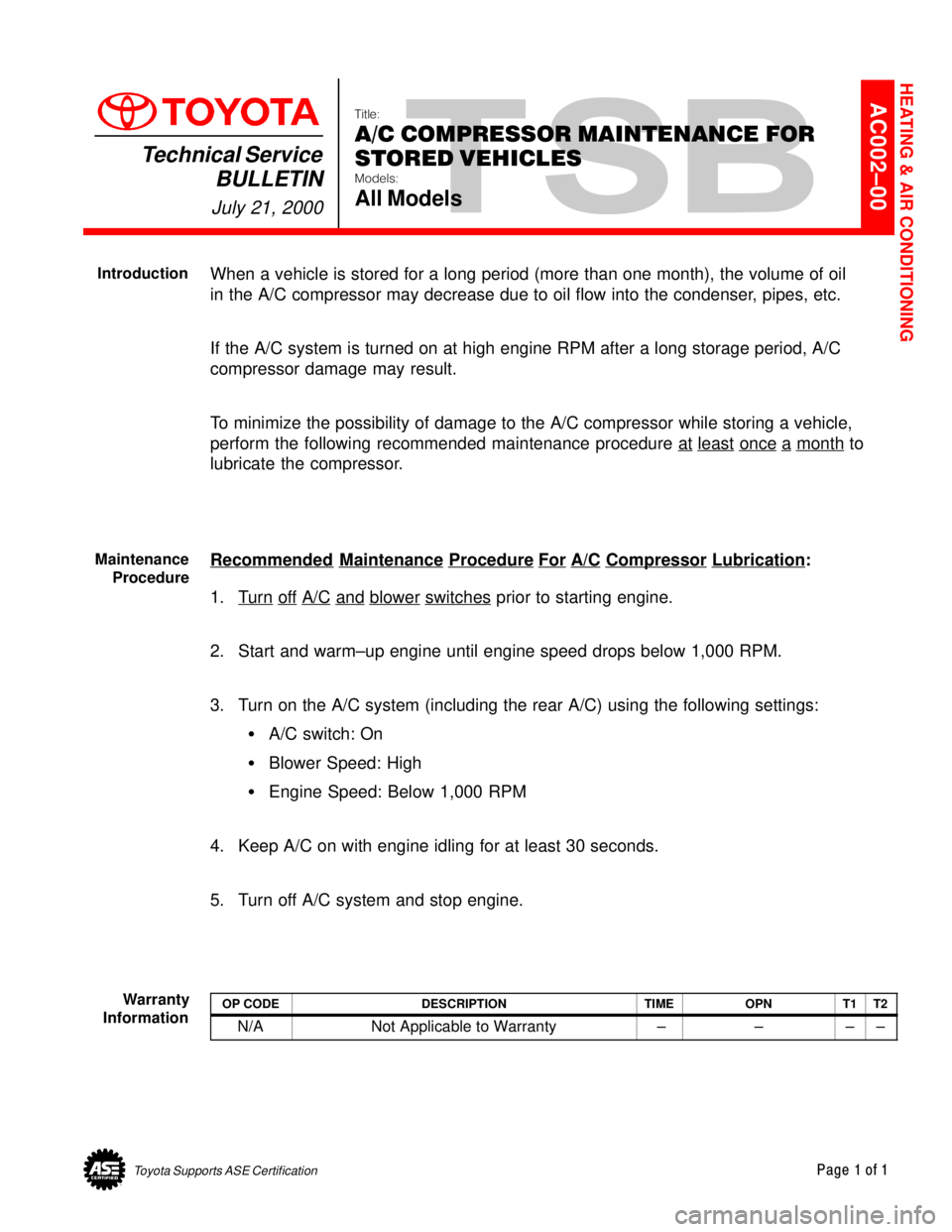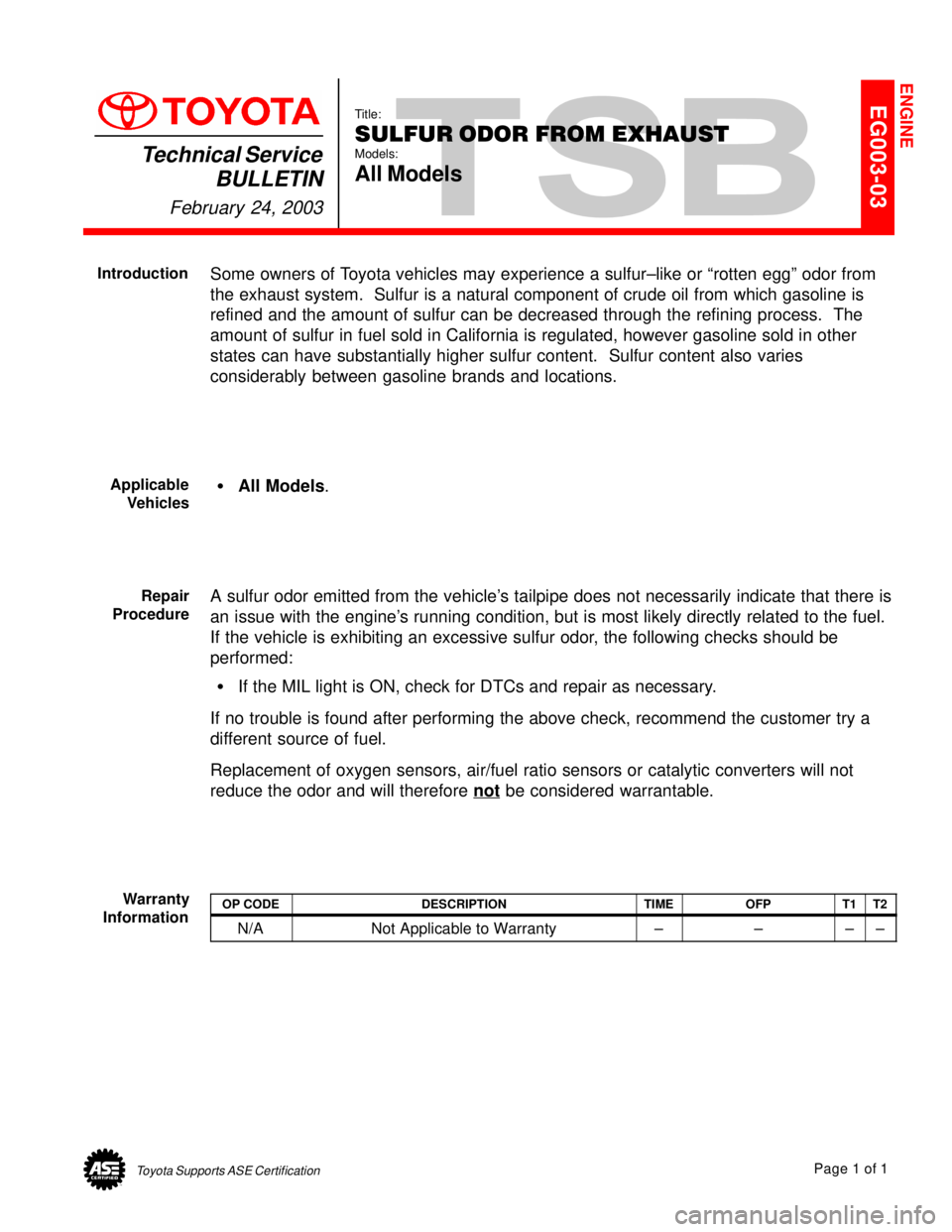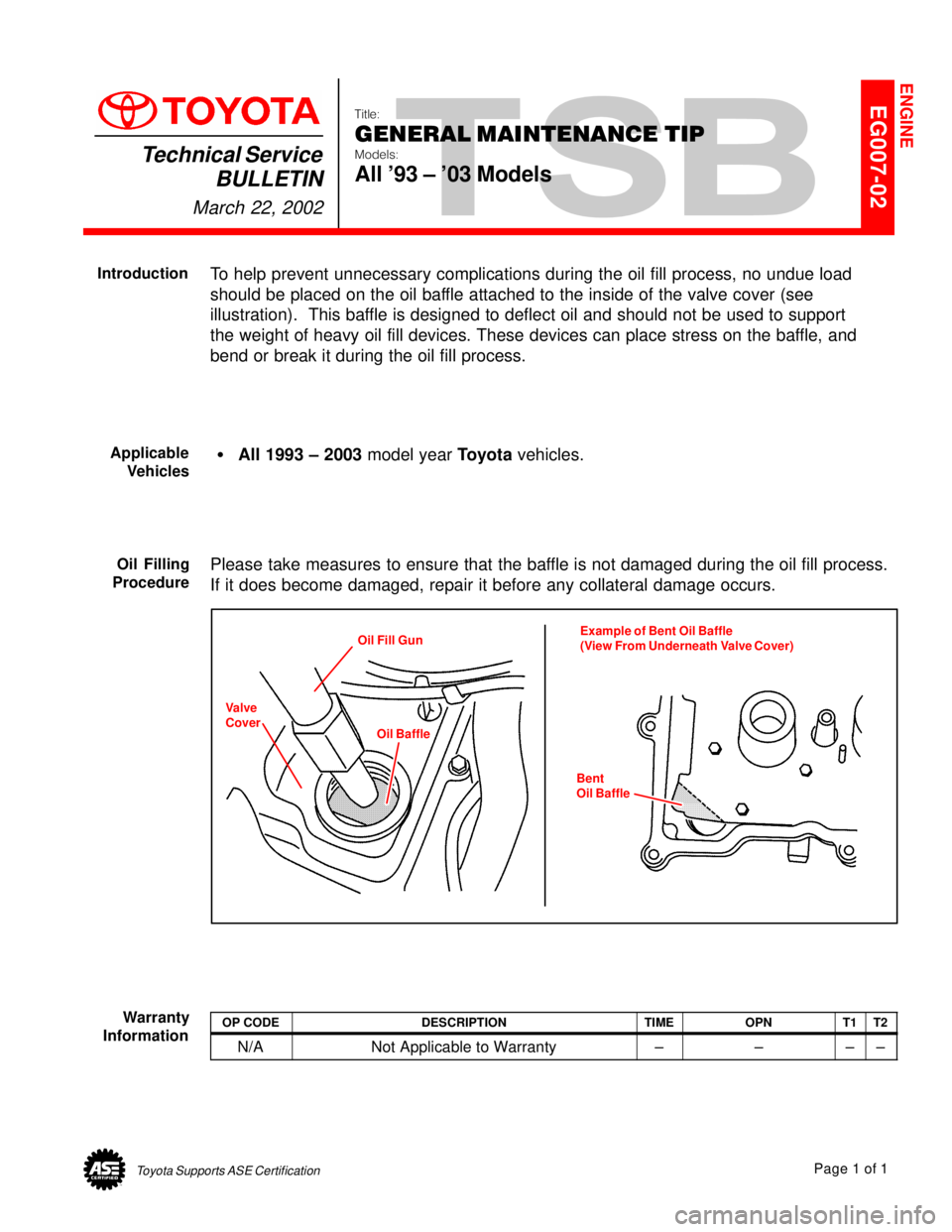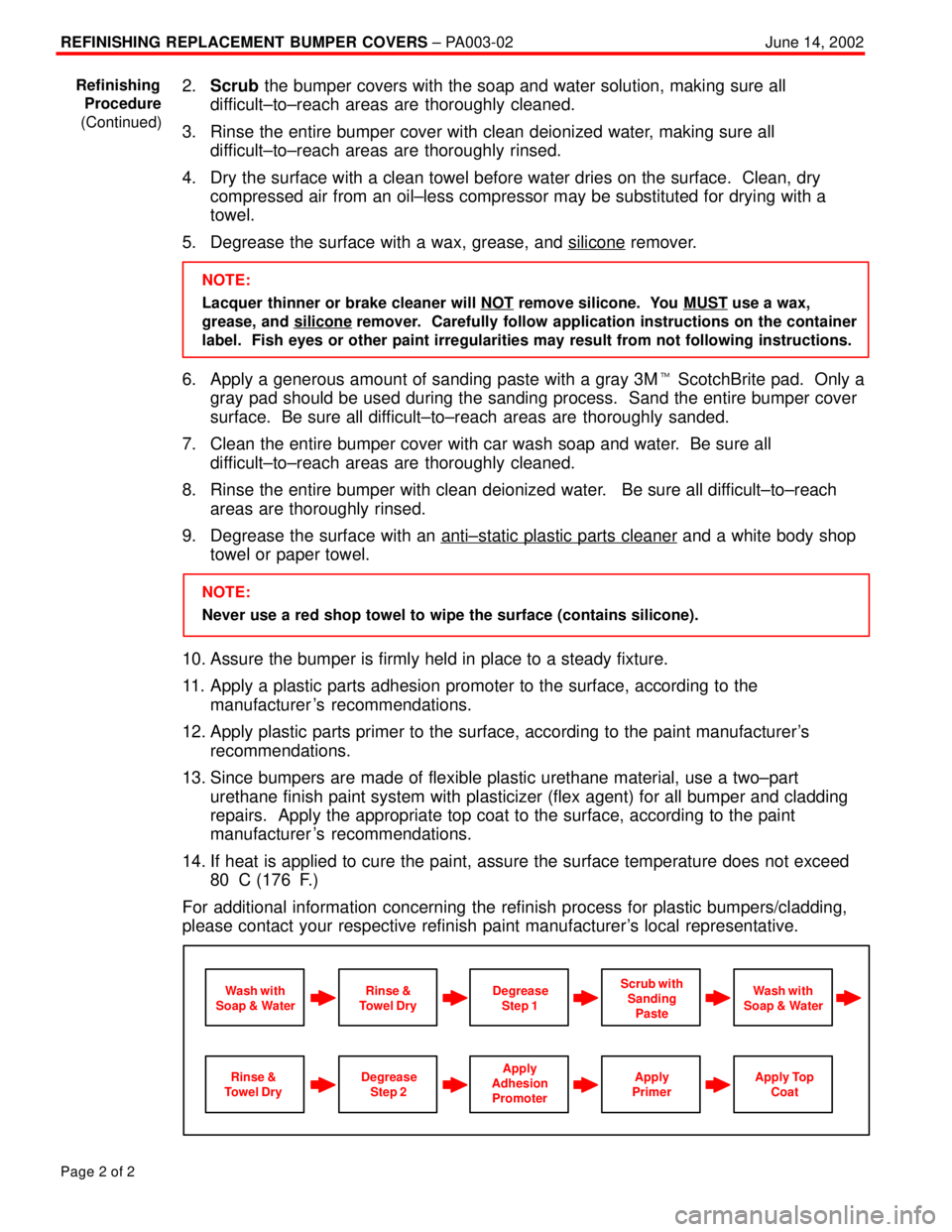Page 4415 of 4770

Toyota Supports ASE CertificationPage 1 of 1
AC002±00
Title:
A/C COMPRESSOR MAINTENANCE FOR
STORED VEHICLES
Models:
All Models
Technical Service
BULLETIN
July 21, 2000
When a vehicle is stored for a long period (more than one month), the volume of oil
in the A/C compressor may decrease due to oil flow into the condenser, pipes, etc.
If the A/C system is turned on at high engine RPM after a long storage period, A/C
compressor damage may result.
To minimize the possibility of damage to the A/C compressor while storing a vehicle,
perform the following recommended maintenance procedure at
least once a month to
lubricate the compressor.
Recommended
Maintenance Procedure For A/C Compressor Lubrication:
1. Turn
off A/C and blower switches prior to starting engine.
2. Start and warm±up engine until engine speed drops below 1,000 RPM.
3. Turn on the A/C system (including the rear A/C) using the following settings:
�A/C switch: On
�Blower Speed: High
�Engine Speed: Below 1,000 RPM
4. Keep A/C on with engine idling for at least 30 seconds.
5. Turn off A/C system and stop engine.
OP CODEDESCRIPTIONTIMEOPNT1T2
N/ANot Applicable to Warranty ±±±±
HEATING & AIR CONDITIONING
Introduction
Maintenance
Procedure
Warranty
Information
Page 4426 of 4770

TSB
Title:
1997 CAMRY REAR SPOILER INSTALLATION
Models:
`97 Camry
IntroductionUpon installation of the rear spoiler, as outlined in the Dealer Installation Instruction sheet
enclosed with the spoiler, please follow the outlined procedure for verification of the trunk
lid operation:
Affected1997 Model Year Camry.
Vehicles
Procedure1. Reinstall the carpet trim panel on the
inside of the trunk lid with the
appropriate fasteners.
2. The trunk lid must remain open and
hold its position, up to approximately
45 degrees from horizontal as shown.
3. If the trunk lid does not hold its open
position and the trunk lid closes:
a. Move the end of one of the torsion
rods to the next upper open slot.
b. Verify that the trunk lid functions
as outlined above.
c. If the condition is not corrected,
adjust the other torsion bar to
the next upper open slot position.
4. If the trunk lid does not hold its open
position and the trunk lid opens fully
forcibly:
a. Move the end of one of the torsion
rods to the next lower open slot
position.
b. Verify that the trunk lid functions
as outlined above.
c. If the condition is not corrected,
please adjust the other torsion
bar to the next lower open slot
position.
ACCESSORY
April 25, 1997
Page 1 of 1
AX005-97
NOTE:
Upon completion of the procedure
described in this bulletin, please refer
to the Dealer Installation Instructions
for final checks.
Upper Slot
Lower Slot
Page 4453 of 4770

On some Toyota models, when Rapgard is removed from the vehicle, a stain is left on the paint
surface. This stain can be seen under the clear coat and is not a defect of the clear coat. The
stain corresponds to a wrinkled area of Rapgard which retained liquids, such as window washer
fluid, that left a discoloration.
REPAIR PROCEDURE:
To remove a stain from a vehicle, heat the stain surface to a temperature of 70�C ± 80�C.
When the stain is removed it will not reappear.
Equipment ±
1. Infrared lamp or dryer to heat the surface.
2. Aluminum foil or a damp cloth to protect plastic parts from deformation.
Procedure ±
1. Apply aluminum foil to adjoining plastic parts or cool with damp cloth periodically.
2. Use an infrared lamp or dryer on the stain developed area and heat for 5 to 10 minutes
at 70�C ± 80�C.
3. After heating for 5 minutes, check whether the stain has disappeared. If the stain still
remains, reheat the area and check again.
NOTE:Take care that the body's paint surface temperature does not become too high.
WARRANTY INFORMATION:
STAINS ON RAPGARD APPLIED AREASPage 1 of 1
AUGUST 9, 1996
BODY
BO008±96
ALL MODELS
OPCODE DESCRIPTION TIME OPN T1 T2
BD6004Remove stains from paint surface
caused by Rapguard0.653301±XXXXX 61 99
Stain
Page 4555 of 4770

Toyota Supports ASE CertificationPage 1 of 1
EG003-03Title:
SULFUR ODOR FROM EXHAUST
Models:
All Models
Technical Service
BULLETIN
February 24, 2003
Some owners of Toyota vehicles may experience a sulfur±like or ªrotten eggº odor from
the exhaust system. Sulfur is a natural component of crude oil from which gasoline is
refined and the amount of sulfur can be decreased through the refining process. The
amount of sulfur in fuel sold in California is regulated, however gasoline sold in other
states can have substantially higher sulfur content. Sulfur content also varies
considerably between gasoline brands and locations.
�All Models.
A sulfur odor emitted from the vehicle's tailpipe does not necessarily indicate that there is
an issue with the engine's running condition, but is most likely directly related to the fuel.
If the vehicle is exhibiting an excessive sulfur odor, the following checks should be
performed:
�If the MIL light is ON, check for DTCs and repair as necessary.
If no trouble is found after performing the above check, recommend the customer try a
different source of fuel.
Replacement of oxygen sensors, air/fuel ratio sensors or catalytic converters will not
reduce the odor and will therefore not
be considered warrantable.
OP CODEDESCRIPTIONTIMEOFPT1T2
N/ANot Applicable to Warranty±±±±
ENGINE
Introduction
Applicable
Vehicles
Repair
Procedure
Warranty
Information
Page 4574 of 4770

Toyota Supports ASE CertificationPage 1 of 1
EG007-02Title:
GENERAL MAINTENANCE TIP
Models:
All '93 ± '03 Models
Technical Service
BULLETIN
March 22, 2002
To help prevent unnecessary complications during the oil fill process, no undue load
should be placed on the oil baffle attached to the inside of the valve cover (see
illustration). This baffle is designed to deflect oil and should not be used to support
the weight of heavy oil fill devices. These devices can place stress on the baffle, and
bend or break it during the oil fill process.
�All 1993 ± 2003 model year Toyota vehicles.
Please take measures to ensure that the baffle is not damaged during the oil fill process.
If it does become damaged, repair it before any collateral damage occurs.
Oil Fill Gun
Oil BaffleExample of Bent Oil Baffle
(View From Underneath Valve Cover)
Bent
Oil Baffle
Valve
Cover
OP CODEDESCRIPTIONTIMEOPNT1T2
N/ANot Applicable to Warranty±±±±
ENGINE
Introduction
Applicable
Vehicles
Oil Filling
Procedure
Warranty
Information
Page 4616 of 4770

REFINISHING REPLACEMENT BUMPER COVERS ± PA003-02June 14, 2002
Page 2 of 2
2.Scrub the bumper covers with the soap and water solution, making sure all
difficult±to±reach areas are thoroughly cleaned.
3. Rinse the entire bumper cover with clean deionized water, making sure all
difficult±to±reach areas are thoroughly rinsed.
4. Dry the surface with a clean towel before water dries on the surface. Clean, dry
compressed air from an oil±less compressor may be substituted for drying with a
towel.
5. Degrease the surface with a wax, grease, and silicone
remover.
NOTE:
Lacquer thinner or brake cleaner will NOT
remove silicone. You MUST use a wax,
grease, and silicone
remover. Carefully follow application instructions on the container
label. Fish eyes or other paint irregularities may result from not following instructions.
6. Apply a generous amount of sanding paste with a gray 3M� ScotchBrite pad. Only a
gray pad should be used during the sanding process. Sand the entire bumper cover
surface. Be sure all difficult±to±reach areas are thoroughly sanded.
7. Clean the entire bumper cover with car wash soap and water. Be sure all
difficult±to±reach areas are thoroughly cleaned.
8. Rinse the entire bumper with clean deionized water. Be sure all difficult±to±reach
areas are thoroughly rinsed.
9. Degrease the surface with an anti±static plastic parts cleaner
and a white body shop
towel or paper towel.
NOTE:
Never use a red shop towel to wipe the surface (contains silicone).
10. Assure the bumper is firmly held in place to a steady fixture.
11. Apply a plastic parts adhesion promoter to the surface, according to the
manufacturer 's recommendations.
12. Apply plastic parts primer to the surface, according to the paint manufacturer's
recommendations.
13. Since bumpers are made of flexible plastic urethane material, use a two±part
urethane finish paint system with plasticizer (flex agent) for all bumper and cladding
repairs. Apply the appropriate top coat to the surface, according to the paint
manufacturer 's recommendations.
14. If heat is applied to cure the paint, assure the surface temperature does not exceed
80�C (176�F. )
For additional information concerning the refinish process for plastic bumpers/cladding,
please contact your respective refinish paint manufacturer's local representative.
Apply
Primer
Wash with
Soap & WaterScrub with
Sanding
PasteWash with
Soap & WaterRinse &
Towel DryDegrease
Step 1
Apply
Adhesion
PromoterApply Top
CoatRinse &
Towel DryDegrease
Step 2
Refinishing
Procedure
(Continued)
Page 4645 of 4770

WARRANTY PARTS MARKING PROCEDURE ± PG006-03September 26, 2003
Page 2 of 3
Dealers are requested to mark the location of the failure of all warranty parts that are
listed below.
This list is not inclusive. There may be other components that can be
marked in the area of failure. All other parts that can be marked should be marked.
assist grip assy headlamps
audio (blemish) headliner
back door garnish hoses
bumper covers instrument panel safety pad sub±assy
cargo cover (retractable) Interior light assemblies and covers
carpet knobs, levers, handles
clutch disc l/pulley pump assy
clutch flywheel mirrors (side and rearview)
combination meter glass navigation or VES screens
console and components pillar garnish
cowl assy rack and pinion/power steering gear assy
cowl side trim sub±assy radiator
cupholders room partition board
cylinder head cover sub±assy rotors (mark where min. runout is exceeded or warped)
dash panel insulator assy seat covers/cushions
dashboard and trim seat tracks
disc wheel soft trim
display panels spare tire cover
door handle assy steering column cover
door moulding steering wheel
door trim panel & molding tail lamps and covers
emblems transmission oil pan
engine oil pan visor
exhaust manifold washer jar
floor and cargo mats wheel cap
gear shift knob wheels
grills
Parts
Marking
Requirement
Parts
Marking
List
Page 4646 of 4770
WARRANTY PARTS MARKING PROCEDURE ± PG006-03September 26, 2003
Page 3 of 3
NOTE:
The following parts do not have to be marked unless the technician can determine
failure and location.
air induction/ejection systems fuel injection systems
all computers fuel injectors
alternators fuel pump
audio (internal) ignition system
batteries internal engine components
bearings internal transmission components
belts oil cooler
catalytic converter power door lock switches
crankshaft remanufactured parts
cruise control starters
distributors suspension components
EGR systems valve covers
engine control systems window regulators
exchange parts wiper motors
exhaust systems
Parts
Marking
List
(Continued)